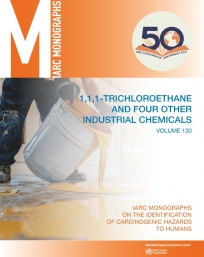
978-92-832-0170-0
978-92-832-0197-7
View The Lancet Oncology summary as HTML or PDF
French version of The Lancet Oncology summary (hosted by Centre Léon Bérard)
Read Q&A
View infographic
This volume of the IARC Monographs provides evaluations of the carcinogenicity of five industrial chemicals: 1,1,1-trichloroethane, 1,2-diphenylhydrazine, diphenylamine, N-methyloIacrylamide, and isophorone.
1,1,1-Trichloroethane was used extensively until the 1990s as a solvent, metal degreaser, chemical intermediate. Since the Montreal Protocol on Substances that Deplete the Ozone Layer, production and use have dwindled, and it is now mostly used as a chemical feedstock in closed systems and for “essential uses”. Poorly documented non-essential uses might occur in low-income and middle-income countries.
1,2-Diphenylhydrazine was primarily used as an intermediate in the manufacture of benzidine dyes, which has ceased in the USA and European Union, although production might occur elsewhere. Additional uses include as an intermediate in drug manufacture.
Diphenylamine, N-methylolacrylamide, and isophorone are High Production Volume chemicals and intermediates used for a wide range of industrial applications. The use of diphenylamine in agrochemicals to prevent fruit scalding is prohibited in the European Union, but ongoing in the USA and elsewhere. Isophorone has been detected in numerous polymer-based products from food packaging to aquatic inflatables, and in food items, possibly because of agrochemical contamination or migration from packaging.
For all agents, data were sparse regarding exposure levels (apart from 1,1,1-trichloroethane, for which data were available mainly on exposures pre-dating the adoption of the Montreal Protocol), but indicated that exposures are higher in occupational situations than in the general population.
An IARC Monographs Working Group reviewed evidence from cancer studies in humans (available for 1,1,1-trichloroethane), cancer bioassays in experimental animals, and mechanistic studies to assess the carcinogenic hazard to humans of exposure to these agents and concluded that:
Annex 1: Supplementary material for 1,1,1-trichloroethane, Section 1, Exposure Characterization
These supplementary web-only tables were produced in draft form by the Working Group and were subsequently fact-checked but not edited.
Please report any errors to imo@iarc.who.int.
Table S1.6 Relationships between 1,1,1-trichloroethane and other substances assessed for exposure
Annex 2: Supplementary material for Section 4, Mechanistic Evidence
These supplementary web-only tables contain summaries of the findings (including the assay name, the corresponding key characteristic, the resulting “hit calls” both positive and negative, and any reported caution flags) for those chemicals evaluated in the present volume that have been tested in high-throughput screening assays performed by the United States Environmental Protection Agency (US EPA) and the United States National Institutes of Health. The results were generated by the Working Group using the software “kc-hits” (key characteristics of carcinogens – high-throughput screening discovery tool) available from https://gitlab.com/i1650/kc-hits.git, with the US EPA Toxicity Forecaster (ToxCast) assay data and the curated mapping of key characteristics to assays available at the time of the evaluations performed for IARC Monographs Volume 130. Data were available for 1,1,1-trichloroethane, 1,2-diphenylhydrazine, diphenylamine, and isophorone, but not N-methylolacrylamide.
Please report any errors to imo@iarc.who.int.
Table S2.4 Isophorone: ToxCast/Tox21 assay results mapped to the key characteristics of carcinogens
Annex 3: Supplementary material for isophorone, Section 1, Exposure Characterization
This table was produced in draft form by the Working Group and was subsequently fact-checked but not edited. Please report any errors to imo@iarc.who.int.